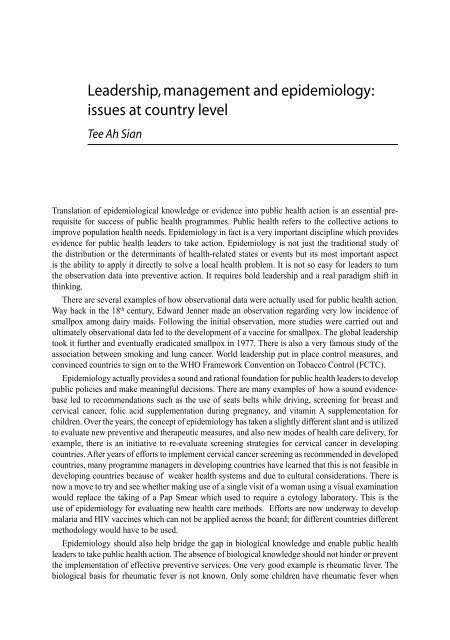South-East Asia Regional Conference on Epidemiology
South-East Asia Regional Conference on Epidemiology
South-East Asia Regional Conference on Epidemiology
You also want an ePaper? Increase the reach of your titles
YUMPU automatically turns print PDFs into web optimized ePapers that Google loves.
Leadership, management and epidemiology:<br />
issues at country level<br />
Tee Ah Sian<br />
Translati<strong>on</strong> of epidemiological knowledge or evidence into public health acti<strong>on</strong> is an essential prerequisite<br />
for success of public health programmes. Public health refers to the collective acti<strong>on</strong>s to<br />
improve populati<strong>on</strong> health needs. <strong>Epidemiology</strong> in fact is a very important discipline which provides<br />
evidence for public health leaders to take acti<strong>on</strong>. <strong>Epidemiology</strong> is not just the traditi<strong>on</strong>al study of<br />
the distributi<strong>on</strong> or the determinants of health-related states or events but its most important aspect<br />
is the ability to apply it directly to solve a local health problem. It is not so easy for leaders to turn<br />
the observati<strong>on</strong> data into preventive acti<strong>on</strong>. It requires bold leadership and a real paradigm shift in<br />
thinking.<br />
There are several examples of how observati<strong>on</strong>al data were actually used for public health acti<strong>on</strong>.<br />
Way back in the 18th century, Edward Jenner made an observati<strong>on</strong> regarding very low incidence of<br />
smallpox am<strong>on</strong>g dairy maids. Following the initial observati<strong>on</strong>, more studies were carried out and<br />
ultimately observati<strong>on</strong>al data led to the development of a vaccine for smallpox. The global leadership<br />
took it further and eventually eradicated smallpox in 1977. There is also a very famous study of the<br />
associati<strong>on</strong> between smoking and lung cancer. World leadership put in place c<strong>on</strong>trol measures, and<br />
c<strong>on</strong>vinced countries to sign <strong>on</strong> to the WHO Framework C<strong>on</strong>venti<strong>on</strong> <strong>on</strong> Tobacco C<strong>on</strong>trol (FCTC).<br />
<strong>Epidemiology</strong> actually provides a sound and rati<strong>on</strong>al foundati<strong>on</strong> for public health leaders to develop<br />
public policies and make meaningful decisi<strong>on</strong>s. There are many examples of how a sound evidencebase<br />
led to recommendati<strong>on</strong>s such as the use of seats belts while driving, screening for breast and<br />
cervical cancer, folic acid supplementati<strong>on</strong> during pregnancy, and vitamin A supplementati<strong>on</strong> for<br />
children. Over the years, the c<strong>on</strong>cept of epidemiology has taken a slightly different slant and is utilized<br />
to evaluate new preventive and therapeutic measures, and also new modes of health care delivery, for<br />
example, there is an initiative to re-evaluate screening strategies for cervical cancer in developing<br />
countries. After years of efforts to implement cervical cancer screening as recommended in developed<br />
countries, many programme managers in developing countries have learned that this is not feasible in<br />
developing countries because of weaker health systems and due to cultural c<strong>on</strong>siderati<strong>on</strong>s. There is<br />
now a move to try and see whether making use of a single visit of a woman using a visual examinati<strong>on</strong><br />
would replace the taking of a Pap Smear which used to require a cytology laboratory. This is the<br />
use of epidemiology for evaluating new health care methods. Efforts are now underway to develop<br />
malaria and HIV vaccines which can not be applied across the board; for different countries different<br />
methodology would have to be used.<br />
<strong>Epidemiology</strong> should also help bridge the gap in biological knowledge and enable public health<br />
leaders to take public health acti<strong>on</strong>. The absence of biological knowledge should not hinder or prevent<br />
the implementati<strong>on</strong> of effective preventive services. One very good example is rheumatic fever. The<br />
biological basis for rheumatic fever is not known. Only some children have rheumatic fever when









